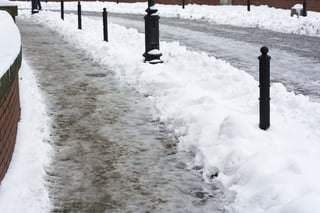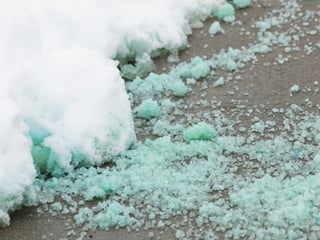Did you know there are over 40 million emergency room visits due to injuries over a year in the US? The National Hospital Ambulatory Medical Care study found there are 10,612,000 visits due to unintentional falls. With the proper preparation you can prevent falls from happening on or near your facility this winter. Here are five things you should know about ice melt and how to successfully prepare your facility for a safe winter.
1. The Risk of Not Using It. To save money or time some opt not to use ice melt. Not applying ice melt in the proper manner can result in slips near your office. Take action to prevent people from slips. Protecting staff and visitors starts before the snow falls. Be aware of who on your team, whether contractor, operations or facilities staff, are responsible for ice melt application and winter weather preparation.
2. Using Too Much. Overusing ice melt can lead to the product being unnecessarily tracked into the facility. Proper application is crucial when using ice melt and other treatments. If not used properly it can burn vegetation around where it is used.
3. Applying It Wrong. Yes, you can indeed apply ice melt improperly. Reading application directions for ice melt is important for determining quantity and to be sure you use the product correctly. Ideally it should be applied evenly on a clean surface before snow falls or immediately after you clear the snow. If possible use a handheld fertilizer spreader for even distribution. Cups and shovels tend to distribute ice melt in clumps. If you use those methods take care to spread as evenly as possible.
4. Using the Wrong Kind. While rock salt is a type of ice melt, it has its limitations. Rock salt can be damaging to concrete and it only melts ice when the temperature is 25 degrees or higher. Miller's Green Scapes ice melt is a more environmentally sound choice. It's safe to use around vegetation and it's green color serves as a great visual that let's staff and visitors know the area has been treated. Most importantly it effectively melts snow in temperatures as low as 10 degrees.
5. Not Cleaning it Up. Your staff and visitors may trek through wet pathways before they enter your facility or workplace. Tracked in ice melt residue is unattractive and has the potential to damage floors. Some ice melts can leave behind an oily substance which can be slippery on a smooth floor surface. Ensure each step is a safe one from the parking lots to your main lobby. As part of your preparation floor mats and caution wet floor signs may be an essential piece of preventing slips this winter.
The winter months can be unpredictable and vary from little snow to a surprisingly significant accumulation. Be prepared. If you would like assistance in prepping your office for winter weather, contact your account manager or complete the form below.
Source: Ice Melt Do's and Don'ts, CleanLink, Home of Sanitary Maintenance, Contracting Profits, and Facility Cleaning Decisions magazines.



.jpg?width=320&name=Untitled%20design%20(24).jpg)
.jpg?width=320&name=Untitled%20design%20(29).jpg)
.jpg?width=320&name=Untitled%20design%20(26).jpg)

